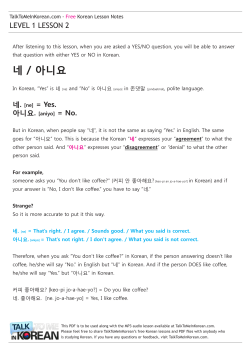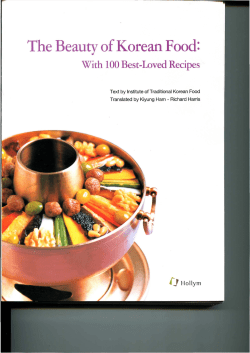
City University of Hong Kong Information on a Course
City University of Hong Kong Information on a Course offered by Department of Asian and International Studies with effect from Semester A 2014 / 2015 Part I Course Title: Korean I Course Code: AIS2973 Course Duration: No. of Credit Units: Level: 1 semester 3 B2 Medium of Instruction: English / Korean Medium of Assessment: English / Korean Pre-requisites: (Course Code and Title) Precursors: (Course Code and Title) Nil Nil Equivalent Courses: (Course Code and Title) LS10681 General Korean I, CTL3973 Korean Language and Culture I, CTL2973 Korean I Exclusive Courses: (Course Code and Title) Nil Part II 1. Course Aims: The course aims to provide practical skills and knowledge in Korean language to the students with no prior knowledge of the Korean language. Students will learn to read and write the Korean alphabet (Hangeul) and master its sound system; build up knowledge in the basic grammar of Korean; and acquire simple key expressions that are based on daily activities. Certain cultural aspects will be also introduced through media sources and various activities as a means to understand Korean culture and society. 1 2. Course Intended Learning Outcomes (CILOs) Upon successful completion of this course, students should be able to: No. CILOs 1. 2. 3. 4. 5. 6. Weighting (if applicable) Master the sound system of Korean alphabet, Hangeul Identify and compose the syllabic units Demonstrate a knowledge of basic grammar of the Korean language Recognize the key expressions based on daily activities such as greetings, shopping and food ordering Identify some of the key features in Korean culture and customs. Discover and learn about Korean usage when reading text and listening to speech in this language. *Notes on weighting: Being able to grasp the basics of Korean syllable structure and to read a simple word (by recognizing the syllable structure and combining the consonants and vowels into syllabic units) requires at least 6-7 weeks for our students. Thus, we will give heavy weights for reading and writing alphabet in this introductory course in order to advance the next level. 3. Teaching and learning Activities (TLAs) (designed to facilitate students’ achievement of the CILOs) Final details will be provided to students in their first week of attendance in this course. ILO No 1,6 2,6 3,6 TLAs Syllables and structure of Hangeul system are explained through mini lectures; Group/individual activities to enable students to compare and contrast the sounds of vowels and consonants through a variety of exercises (textbook, supplementary exercises, online resources and computer software) Students are enabled in recognizing the syllable structures through dictations, word games and exercises; Lab sessions and online assignments to enable students to type Korean fonts so that they can search relevant information from online resources (online dictionary, Korean learning sites, online media sites, etc.) Basic concepts in Korean grammar such as word order, sentence patterns, and present tense rules are explained through mini lectures; Students are engaged in various communicative activities to to acquire simple grammatical patterns in pair or group; Students are enabled to compose sentences with basic sentence patterns through the textbook, and other supplementary resources in the tutorials. 2 Hours/week (if applicable) 1 1 0.25 4,6 5 4. Students are enabled to produce key expressions in Korean daily activities through the textbook, and other supplementary resources such as , listening exercises, audio/visual exercises, and online resources; A variety of role-plays and simulation games to enable students to communicate with basic daily expressions. Students are enabled to identify the key concepts in Korea’s traditional culture through mini-lectures, class discussions and group presentation; Students are given hands-on opportunities for experiencing Korean customs and festivals (e.g., wearing Korean traditional dress, Hanbok, performing folk games, etc.) 0.5 0.25 Assessment Tasks/Activities (designed to assess how well the students achieve the CILOs) Final details will be provided to students in their first week of attendance in this course. ILO No CILO 1 CILO 2 CILO 3 CILO 4 CILO 5 Type of assessment tasks/activities Knowledge on sound system of Hangeul will be assessed in listening and written quizzes Written and listening quizzes on identifying and recognizing syllable structure will be given in class individually Students are required to demonstrate their understanding of word order, present tense rules in quizzes and activities Written and listening quizzes on basic expressions will be given in class in a group and/or individually Reading test and oral test will be given in class individually from the textbooks and other supplementary materials which contains key words and expressions With a topic of their choice, students are required to conduct a group presentation on Korean culture to teach key concepts and vocabulary related to their topics. 3 Weighting (if applicable) 3 3 1 2 1 Remarks 5. Grading of Student Achievement: Refer to Grading of Courses in the Academic Regulations Excellent A+ A AGeneral Excellent command of knowledge in Hangeul, basic vocabulary, expressions and grammar patterns commonly used in daily activities. Reading Excellent & Writing command of reading and writing CV/CVC words, and simple sentences learned in class. Good B+ B BGood command of knowledge in Hangeul, basic vocabulary, expressions and grammar patterns commonly used in daily activities. Adequate C+ C CAdequate command of knowledge in Hangeul, basic vocabulary, expressions and grammar patterns commonly used in daily activities. Good command of reading and writing CV/CVC words, and simple sentences learned in class. Adequate command of reading and writing CV/CVC words, and simple sentences learned in class. Marginal D Marginal command of knowledge in Hangeul, basic vocabulary, expressions and grammar patterns commonly used in daily activities. Marginal command of reading and writing CV/CVC words, and simple sentences learned in class. Speaking Good speaking skills to produce clear and fluent speech for a level; to apply proper expressions to the context without any errors (e.g. grammar, pronunciation and/or context). Adequate speaking skills to produce somewhat comprehensible speech; to apply learned expressions to the context with frequent errors (e.g. grammar, pronunciation and/or context). Marginal speaking skills to produce incomprehensible speech; to apply learned expressions to the context with heavy errors (e.g. grammar, pronunciation and/or context). Good listening comprehension skills to apply previously learned expressions into context. Adequate listening comprehension skills to apply previously learned expressions into context. Marginal listening comprehension skills to apply previously learned expressions into context. Listening Excellent speaking skills to produce clear and fluent speech for a level; to apply proper expressions to the context without any errors (e.g. grammar, pronunciation and/or context). Excellent listening comprehension skills to apply previously learned expressions into context. Grading pattern: Standard (A+, A, A-...F). Grading is based on student’s performance in assessment tasks/activities. Final details will be provided to students in their first week of attendance in this course. 4 Part III Keyword Syllabus: Korean Language: Pronouncing and writing Korean consonants and vowels of the Korean Alphabet, Hangeul; identifying and composing syllabic units; basic word order, present tenses rules; greetings; Sino-Korean numbers and shopping expressions, ordering at the restaurant; Korean Culture: brief history of Hangeul; Korean traditional dress (Hanbok); festivals; food. Recommended Reading: Text(s): Cho, I. and Y, Cho (2000) Korean through Active Listening I. Seoul: Hollym Publishing Co. Choo, M. and W, O’Grady (2003) The sounds of Korean : a pronunciation guide. Honolulu : University of Hawaii Press. Ewha Womans University Language Center (2001) Pathfinder in Korean I. Seoul: Ewha Womans University Press. Ewha Language Center (2004) Pathfinder in Korean 1 (vocabulary). Seoul: Ewha Womans University Press. Kim, R. (1997) The Korean Alphabet: Its History and Structure. Honolulu: University of Hawaii Press. Park, B. (2005) Mastering Korean Level One. New York: Barron’s Educational series Inc. Seoul National University Language Education Institute (2000) Korean through English Book 1. Seoul: Hollym Publishing Co. Sogang University Korean Language Institute. (2000) Sogang Korean 1A. Seoul: Hawoo Publishing Co. The National Academy of the Korean Language. (2002) An illustrated guide to Korean culture : 233 traditional key words. Seoul: Hakgojae. U, I. (2000) Easy Korean Grammar: for foreign speakers. Seoul: Korean culture publishing. Online Resources: Sogang University Language Research Institute. Sogang Hangugo http://korean.sogang.ac.kr Seoul National University Language Research Institute. Click Korean http://language.snu.ac.kr/kor/pages/SK00023_01.jsp 5
© Copyright 2025


















